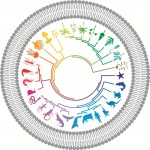
The theory of evolution by natural selection is unarguably the most influential in the history of biology, but it has been dogged with controversy since its inception, and not just because of ideological resistance to its implications for our ancestry. One of the more compelling obstacles to its acceptance has been the existence of extremely complex adaptive structures such as (famously) the eye, which seem to defy explanation by the gradual accrual of random changes. Darwin worried about it, and accepted the contribution of inheritance of acquired characters in part to explain the otherwise apparently inexplicable. This Lamarckist position became untenable however when Weismann established the separation of germline and soma in the late 19th century; and evolutionary biologists have been grappling with the issues ever since.
The problem, as posed by Marc Kirschner in an interview for BMC Biology, is to account for the evolution of novelty – It is not so hard to see how existing structures and processes could be improved by selection: much more difficult to see how anything new could emerge in coherent form. Kirschner charts some landmarks in the recent and not-so-recent history of research on the evolution of novelty, in the course of exploring the molecular mechanisms of evolvability, whereby variability can accumulate and provide the substrate for the emergence of new adaptations.
Birds’ beaks and four-winged flies
Two of the most striking examples cited by Kirschner are the remarkable emergence of new beak morphologies recently described by Tabin and colleagues through manipulation of a single signaling molecule in development; and the four-winged fly whereby Waddington showed sixty years ago that environmentally induced changes could be assimilated into the developmental program of the organism – a startlingly Lamarckian notion that is not as heretical as it may seem. Addressing this, Kirschner develops the argument, among others, that existing developmental and physiological plasticity can provide a rich source of variation on which selection can act without violating either Darwin’s or Weismann’s principles. There are indeed other striking examples at the cellular level, of evolvability under stress. Some of these, operating in prokaryotes, have been described by Koonin and Wolf as ‘quasi-Lamarckian’ – though a less controversial designation would be evolutionary capacitance, recently explored by Masel in a Q&A for BMC Biology in which they take as an example the exposure of cryptic protein variants due to interference with translation termination by the occasional intervention of a prion-like protein.
More things in heaven and earth
Kirschner, in his parting polemic, urges that if we can understand how biological systems evolved we have a much better chance of manipulating them in the interests of preventing or treating disease; and that the inexplicable properties of organisms may better repay examination than their obvious adaptations – for these may be the basis for the evolvability without which nothing as complex as we are could ever have come into being.
Miranda Robertson
Latest posts by Miranda Robertson (see all)
- The scientific Odyssey: Pre-registering the voyage - 3rd May 2017
- A year of almost anything you can think of in life science – an eclectic pick from BMC Biology - 13th January 2017
- Peer review: opting out - 23rd September 2016
One Comment